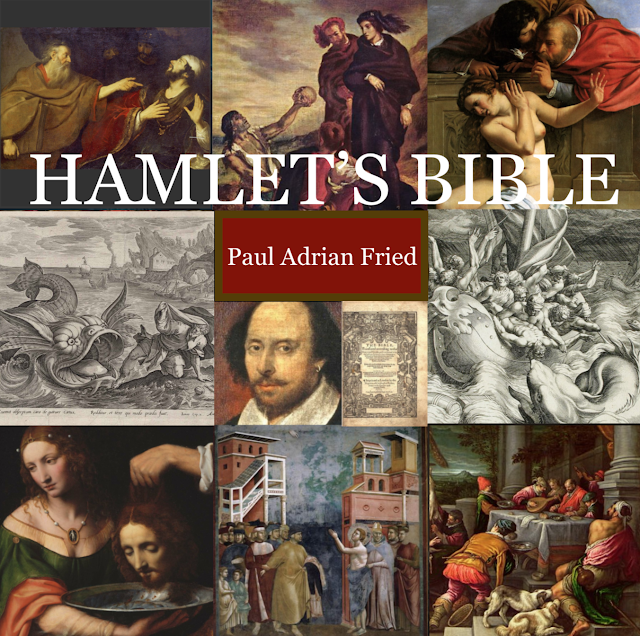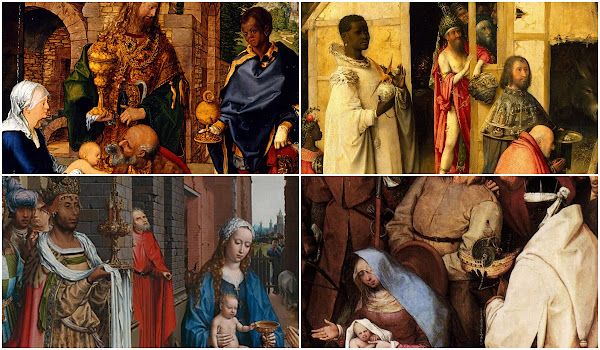Balthasar and Epiphany in Shakespeare and Renaissance Paintings
In a December 2020 article, Jonathan Jones explained how the idea of a black Balthazar among the magi or wise men visiting Jesus was an idea that began to blossom in the Renaissance among painters who portrayed the scene.[1] "Balthazar" was a new name given to the biblical Daniel.
In a text attributed to the Venerable Bede of Northumbria (672/3 – 735), Balthazar was identified as coming from Africa, yet Jones claims that many in Bede’s time had little concept of what color skin an African might have. As Renaissance Europeans became more exposed to people from other parts of the world, the imagining of Balthazar as black expanded with the help of paintings.
Jones notes, “Behind those dark daubs of paint lay a new curiosity about people and about peoples: the ‘humanist’ thinking of the Renaissance that inspired the great French philosopher Montaigne to declare that all global customs and beliefs are equally valid.”
Given this expanding awareness, it is perhaps no surprise that Balthazar became a kind of touchstone or symbol of otherness, diversity, and tolerance.
And so it is also perhaps no surprise that the name Balthasar occurs five times in Shakespeare’s plays,
twice as servants (in Romeo and Juliet, and in The Merchant of Venice),
once as a singer in Much Ado About Nothing,
once as a merchant in The Comedy of Errors,
and once as a lawyer, Portia’s courtroom disguise in The Merchant of Venice, where she is called a "Daniel"; a play in which Portia considers suitors from many lands.
Shakespeare also has a play named after the night before the Epiphany, Twelfth Night. The three Magi are outsiders, foreigners, and so are the siblings in Twelfth Night who are shipwrecked on the island of Illyria, the land of their enemies. But by the end of that play, the siblings both marry leading personages from Illyria, contributing to themes of diversity, tolerance, reconciliation, and loving one’s enemies.
In Hamlet, Horatio describes one encounter with the ghost as “wondrous strange,” and Hamlet responds, “And therefore as a stranger give it welcome.” (1.5.186) [2]
Especially in recent years, many have noted the theme of tolerance and diversity in a refugee speech (“The Stranger’s Case”) written with Shakespeare in a collaboration for the play, Sir Thomas More.[3]
So if Shakespeare seems to have had a fondness for the name of Balthazar in an age when one of the Magi/Wise Men was thought to have been a black African, it may have been more than a poet loving the sound of the name. It may have been like a code word used among playwrights, poets, patrons, and members of the public who were willing to tolerate difference and embrace diversity, things still in need today.
NOTES:
[1] https://www.theguardian.com/artanddesign/2020/dec/21/christmas-cards-star-baby-jesus-myrrh-mystery-balthasar-three-kings-black-art
[2] All references to Hamlet are to the Folger Shakespeare Library online version:
https://shakespeare.folger.edu/shakespeares-works/hamlet/entire-play/
[3] Ian McKellen often performed and promoted “The Stranger’s Case” from Sir Thomas More:
Short: https://youtu.be/9YiZReT60ns
Also short: https://youtu.be/afK_bXD7pMo
Including remarks on the larger context by McKellen: https://youtu.be/kJM6Xd7F4FE
IMAGES, Adoration of the Magi, Balthazar detail/crop:
Albrecht Dürer:
https://commons.wikimedia.org/wiki/Category:Adoration_of_the_Magi_by_D%C3%BCrer#/media/File:Albrecht_D%C3%BCrer_-_Adorazione_dei_Magi_-_Google_Art_Project.jpg
Hieronymus Bosch:
https://commons.wikimedia.org/wiki/File:Hieronymus_Bosch_-_Triptych_of_the_Adoration_of_the_Magi_-_WGA2606.jpg
Jan Gossaert:
https://commons.wikimedia.org/wiki/Category:Adoration_of_the_Kings_by_Jan_Gossaert_(London)#/media/File:Jan_Gossaert_001.jpg
Pieter Bruegel the Elder:
https://commons.wikimedia.org/wiki/File:Pieter_Bruegel_the_Elder_-_The_Adoration_of_the_Kings_-_WGA3461.jpg
~~~~~~~~~~~~~~~~~~~~~~~~
Disclaimer: If and when I quote or paraphrase bible passages or mention religion in many of my blog posts, I do not intend to promote any religion over another, nor am I attempting to promote religious belief in general; only to explore how the Bible and religion influenced Shakespeare, his plays, and his age.
~~~~~~~~~~~~~~~~~~~~~~~~
~~~~~~~~~~~~~~~~~~~~~~~~~~~~~~~~~~~~~~
Thanks for reading!
~~~~~~~~~~~~~~~~~~~~~~~~~~~~~~~~~~~~~~
~~~~~~~~~~~~~~~~~~~~~~~~~~~~~~~~~~~~~~
My current project is a book tentatively titled Hamlet’s Bible, about biblical allusions and plot echoes in Hamlet.
Below is a link to a list of some of my top posts (“greatest hits”), including a description of my book project (last item on the list):
https://pauladrianfried.blogspot.com/2019/12/top-20-hamlet-bible-posts.html
I post every week, so please visit as often as you like and consider subscribing.
To find the subscribe button, see the = drop-down menu with three lines in the upper left.

In a text attributed to the Venerable Bede of Northumbria (672/3 – 735), Balthazar was identified as coming from Africa, yet Jones claims that many in Bede’s time had little concept of what color skin an African might have. As Renaissance Europeans became more exposed to people from other parts of the world, the imagining of Balthazar as black expanded with the help of paintings.
Jones notes, “Behind those dark daubs of paint lay a new curiosity about people and about peoples: the ‘humanist’ thinking of the Renaissance that inspired the great French philosopher Montaigne to declare that all global customs and beliefs are equally valid.”
Given this expanding awareness, it is perhaps no surprise that Balthazar became a kind of touchstone or symbol of otherness, diversity, and tolerance.
And so it is also perhaps no surprise that the name Balthasar occurs five times in Shakespeare’s plays,
twice as servants (in Romeo and Juliet, and in The Merchant of Venice),
once as a singer in Much Ado About Nothing,
once as a merchant in The Comedy of Errors,
and once as a lawyer, Portia’s courtroom disguise in The Merchant of Venice, where she is called a "Daniel"; a play in which Portia considers suitors from many lands.
Shakespeare also has a play named after the night before the Epiphany, Twelfth Night. The three Magi are outsiders, foreigners, and so are the siblings in Twelfth Night who are shipwrecked on the island of Illyria, the land of their enemies. But by the end of that play, the siblings both marry leading personages from Illyria, contributing to themes of diversity, tolerance, reconciliation, and loving one’s enemies.
In Hamlet, Horatio describes one encounter with the ghost as “wondrous strange,” and Hamlet responds, “And therefore as a stranger give it welcome.” (1.5.186) [2]
Especially in recent years, many have noted the theme of tolerance and diversity in a refugee speech (“The Stranger’s Case”) written with Shakespeare in a collaboration for the play, Sir Thomas More.[3]
So if Shakespeare seems to have had a fondness for the name of Balthazar in an age when one of the Magi/Wise Men was thought to have been a black African, it may have been more than a poet loving the sound of the name. It may have been like a code word used among playwrights, poets, patrons, and members of the public who were willing to tolerate difference and embrace diversity, things still in need today.
NOTES:
[1] https://www.theguardian.com/artanddesign/2020/dec/21/christmas-cards-star-baby-jesus-myrrh-mystery-balthasar-three-kings-black-art
[2] All references to Hamlet are to the Folger Shakespeare Library online version:
https://shakespeare.folger.edu/shakespeares-works/hamlet/entire-play/
[3] Ian McKellen often performed and promoted “The Stranger’s Case” from Sir Thomas More:
Short: https://youtu.be/9YiZReT60ns
Also short: https://youtu.be/afK_bXD7pMo
Including remarks on the larger context by McKellen: https://youtu.be/kJM6Xd7F4FE
IMAGES, Adoration of the Magi, Balthazar detail/crop:
Albrecht Dürer:
https://commons.wikimedia.org/wiki/Category:Adoration_of_the_Magi_by_D%C3%BCrer#/media/File:Albrecht_D%C3%BCrer_-_Adorazione_dei_Magi_-_Google_Art_Project.jpg
Hieronymus Bosch:
https://commons.wikimedia.org/wiki/File:Hieronymus_Bosch_-_Triptych_of_the_Adoration_of_the_Magi_-_WGA2606.jpg
Jan Gossaert:
https://commons.wikimedia.org/wiki/Category:Adoration_of_the_Kings_by_Jan_Gossaert_(London)#/media/File:Jan_Gossaert_001.jpg
Pieter Bruegel the Elder:
https://commons.wikimedia.org/wiki/File:Pieter_Bruegel_the_Elder_-_The_Adoration_of_the_Kings_-_WGA3461.jpg
~~~~~~~~~~~~~~~~~~~~~~~~
Disclaimer: If and when I quote or paraphrase bible passages or mention religion in many of my blog posts, I do not intend to promote any religion over another, nor am I attempting to promote religious belief in general; only to explore how the Bible and religion influenced Shakespeare, his plays, and his age.
~~~~~~~~~~~~~~~~~~~~~~~~
~~~~~~~~~~~~~~~~~~~~~~~~~~~~~~~~~~~~~~
Thanks for reading!
~~~~~~~~~~~~~~~~~~~~~~~~~~~~~~~~~~~~~~
~~~~~~~~~~~~~~~~~~~~~~~~~~~~~~~~~~~~~~
My current project is a book tentatively titled Hamlet’s Bible, about biblical allusions and plot echoes in Hamlet.
Below is a link to a list of some of my top posts (“greatest hits”), including a description of my book project (last item on the list):
https://pauladrianfried.blogspot.com/2019/12/top-20-hamlet-bible-posts.html
I post every week, so please visit as often as you like and consider subscribing.
To find the subscribe button, see the = drop-down menu with three lines in the upper left.


Comments
Post a Comment